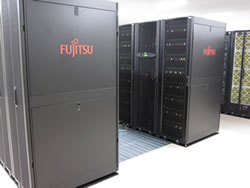Tokyo, March 01, 2010
Fujitsu today announced that it has completed joint development of a new supercomputer system with the Japan Atomic Energy Agency (JAEA). The new supercomputer system went operational today.
Based on the LINPACK(1) performance benchmark, the new system achieved performance of 186.1 teraflops(2), which would make it the fastest supercomputer in Japan based on the latest TOP500(3) list of supercomputers announced in November 2009.
The new system will be used in a variety of areas of atomic energy research, including nuclear fusion simulations. It will also play an important role in ensuring the safe use of atomic energy.
New Supercomputer System
 New Supercomputer System
New Supercomputer SystemThe new system is a hybrid system consisting of three computational server systems, each intended for different purposes: (1) Large-scale Parallel Computation Unit, (2) Application Development Unit for the Next-Generation Supercomputer, and (3) SMP Server (shared memory server). The Large-scale Parallel Computation Unit, which forms the core of the new system, is able to deliver a high-performance parallel computing environment through its use of Fujitsu's latest blade server, PRIMERGY BX900, in a configuration of 2,134 nodes (4,268 CPUs, 17,072 cores) connected using the latest InfiniBand QDR high-speed interconnect technology.
In addition, the next-generation code development unit uses a 300-node FX1 server cluster and the shared memory server uses a single-node SPARC Enterprise M9000 UNIX server. There is also a 36-unit ETERNUS DX80 disk array storage system.
All three server systems run Parallelnavi, Fujitsu's high-performance computing middleware, which delivers a common development and execution environment and unified operations management, thereby ensuring a high level of operability.
Performance Capabilities
Making up the Large-scale Parallel Computation Unit at the heart of the system, the PRIMERGY BX900 servers were benchmarked using LINPACK and achieved a result that would place the new system first among the Japanese entries posted on the most recent TOP500 list (November 2009 edition) of supercomputers, and 19th in the world.
| |
Result |
Compared with TOP500 list (November 2009) |
Measured Environment |
| Performance |
186.1 teraflops |
1st in Japan, 19th in world |
2,134 nodes of PRIMERGY BX900 (theoretical peak performance: 200 teraflops) |
This measurement is the result of a complete system architecture that combines the raw performance of PRIMERGY BX900, the latest blade servers, with Fujitsu's Parallelnavi HPC middleware and system integration technologies such as program tuning.
In particular, by mounting two InfiniBand QDR cards in each blade server one-way data transfers as fast as 8 GBps can be achieved. Furthermore, the science and technical math libraries of Parallelnavi equipped with world-class, high performance features stemming from the technology of Fujitsu Laboratories also contributed greatly to the LINPACK score.
Comment from Toshio Hirayama, Director of the Center for Computational Science and e-Systems of the JAEA
"Supercomputers are indispensible for the kind of scientific computations required in nuclear energy research and development. For that reason, I'm confident that the new supercomputer system will make it possible to bring calculations that had been impractically large within reach. By leveraging this new system, we intend to develop codes for the Next-Generation Supercomputer that will be deployed in 2012."
PRIMERGY BX900
PRIMERGY BX900 is Fujitsu's most advanced blade server for global businesses, with industry-leading mounting density of 18 blades per chassis and a total throughput of 6.4 Tbps, far superior to competing models.
In addition to its use in supercomputers, the PRIMERGY BX900 blade server is well-suited for a wide range of applications, including mission-critical enterprise computing systems, server consolidation, and the building of cloud environments.
